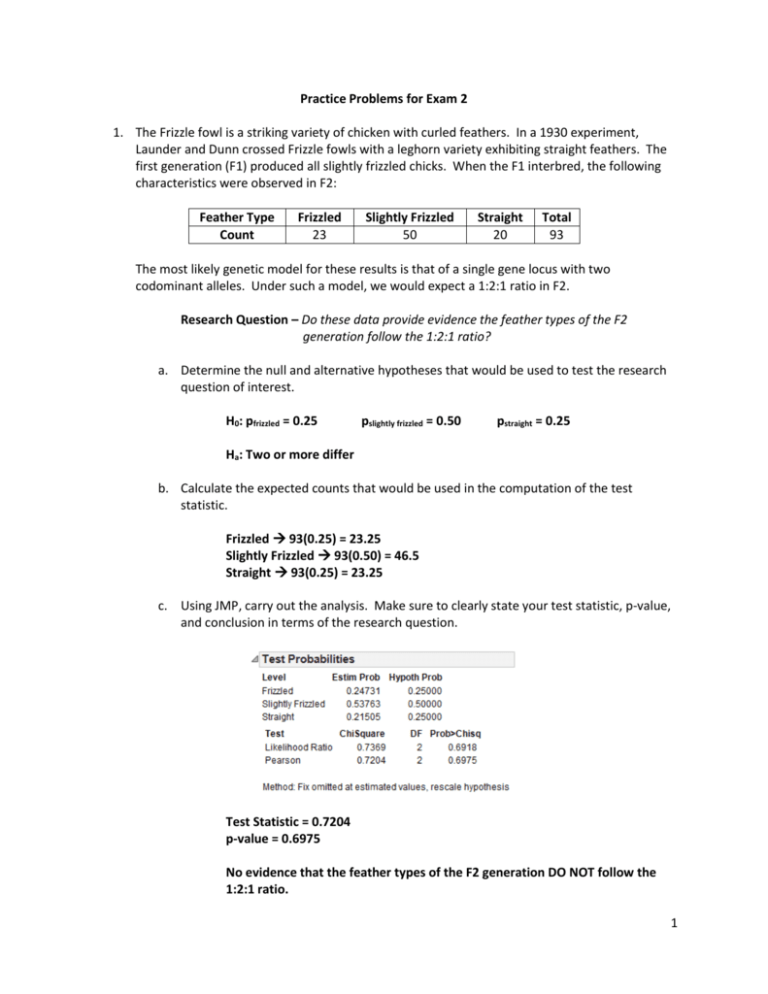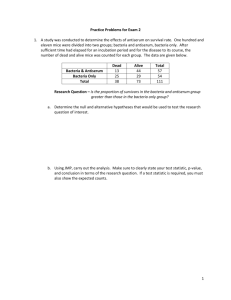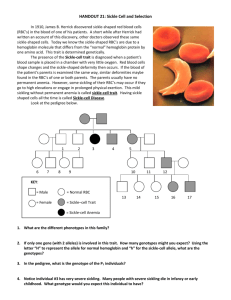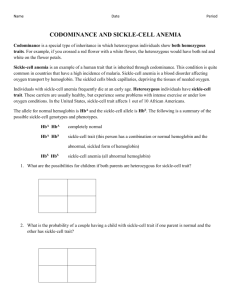Practice Problems for Exam 2 The Frizzle fowl is a striking variety of
advertisement

Practice Problems for Exam 2 1. The Frizzle fowl is a striking variety of chicken with curled feathers. In a 1930 experiment, Launder and Dunn crossed Frizzle fowls with a leghorn variety exhibiting straight feathers. The first generation (F1) produced all slightly frizzled chicks. When the F1 interbred, the following characteristics were observed in F2: Feather Type Count Frizzled 23 Slightly Frizzled 50 Straight 20 Total 93 The most likely genetic model for these results is that of a single gene locus with two codominant alleles. Under such a model, we would expect a 1:2:1 ratio in F2. Research Question – Do these data provide evidence the feather types of the F2 generation follow the 1:2:1 ratio? a. Determine the null and alternative hypotheses that would be used to test the research question of interest. H0: pfrizzled = 0.25 pslightly frizzled = 0.50 pstraight = 0.25 Ha: Two or more differ b. Calculate the expected counts that would be used in the computation of the test statistic. Frizzled 93(0.25) = 23.25 Slightly Frizzled 93(0.50) = 46.5 Straight 93(0.25) = 23.25 c. Using JMP, carry out the analysis. Make sure to clearly state your test statistic, p-value, and conclusion in terms of the research question. Test Statistic = 0.7204 p-value = 0.6975 No evidence that the feather types of the F2 generation DO NOT follow the 1:2:1 ratio. 1 2. A study was conducted to determine the effects of antiserum on survival rate. One hundred and eleven mice were divided into two groups; bacteria and antiserum, bacteria only. After sufficient time had elapsed for an incubation period and for the disease to its course, the number of dead and alive mice was counted for each group. The data are given below. Bacteria & Antiserum Bacteria Only Total Dead 13 25 38 Alive 44 29 73 Total 57 54 111 Research Question – Is the proportion of survivors in the bacteria and antiserum group greater than those in the bacteria only group? a. Determine the null and alternative hypotheses that would be used to test the research question of interest. H0: pbacteria & antiserum ≤ pbacteria only Ha: pbacteria & antiserum > pbacteria only b. Using JMP, carry out the analysis. Make sure to clearly state your test statistic, p-value, and conclusion in terms of the research question. If a test statistic is required, you must also show the expected counts. No Test Statistic p-value = 0.0078 Evidence that the proportion of survivors in the bacteria & antiserum group is greater than those in the bacteria only group. 2 3. Toschke et al. (American Journal of Epidemiology, 2003) collected data on the smoking status of mothers during pregnancy and whether their child was born premature (37 weeks or fewer of gestation) or full term. 3970 mothers participated in the study and of the 406 mothers who were smokers, 36 had premature babies, while 168 of the mothers who were non-smokers had premature babies. a. Fill in the contingency table for the scenario. Smoker Non-Smoker Total Premature Baby 36 168 204 Full Term Baby 370 3396 3766 Total 406 3564 3970 b. Using JMP, find the relative risk of having a premature baby for the smokers compared to the non-smokers. c. Interpret the relative risk found in part b. The risk/probability of a premature baby for smokers is 1.88 times more likely than the risk/probability of a premature baby for non-smokers. d. Using JMP, find and interpret the odds ratio for this scenario. The odds of a full term baby for non-smokers is 1.97 times greater than the odds of a full term baby for smokers. e. According to the relative risk found in part b and the odds ratio found in part d, can a relationship/association between smoking status and having a premature baby be concluded? Explain. Yes, because the RR ≠ 1 and the OR ≠ 1. 3 4. Sickle-cell anemia is a heredity chronic blood disease that is extremely severe when an individual carries two copies of the defective gene. It is particularly common in countries plagued by malaria, a parasitic infection transmitted by mosquitos. A study in Africa tested 543 children for the sickle-cell gene and malaria. Of the children tested, 136 had the sickle-cell gene and 407 did not possess the gene. Of those with the sickle-cell gene, 36 had heavy malaria infections whereas 139 of the children without the sickle-cell gene had heavy malaria infections. Research Question – Is the proportion of children with heavy malaria infections different for those with the sickle-cell gene compared to those without? a. Fill in the contingency table for the scenario. Malaria No malaria Sickle-cell 36 100 No Sickle-cell 139 268 Total 175 368 Total 136 407 543 b. Determine the null and alternative hypotheses that would be used to test the research question of interest. H0: psickle cell = pno sickle cell Ha: psickle cell ≠ pno sickle cell c. Using JMP, carry out the analysis. Make sure to clearly state your test statistic, p-value, and conclusion in terms of the research question. If a test statistic is required, you must also show the expected counts. Expected Counts: Malaria No malaria Sickle-cell 136(0.32) = 43.52 136(0.68) = 92.48 No Sickle-cell 407(0.32) = 130.24 407(0.68) = 276.76 Total 175 368 % overall with malaria = 175/543 = 0.32 % overall without malaria = 368/543 = 0.68 Total 136 407 543 Test Statistic = 2.754 p-value = 0.0970 No evidence that the proportion of children with heavy malaria infections is different for those with the sickle-cell gene compared to those without. 4








